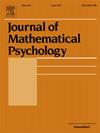通过双效用函数表示区间阶
IF 1.5
4区 心理学
Q2 MATHEMATICS, INTERDISCIPLINARY APPLICATIONS
引用次数: 2
摘要
偏好关系及其表征的阐述可以追溯到早期的经济理论。偏好定理的经典表示依赖于拓扑设置中的Debreu-Eilenberg定理。一类重要的偏好由区间顺序组成。一个自然的问题是实现区间顺序的双实用表示。我们建议引入一个条件,使人想起维纳关于位置相对性的早期著作。我们通过优先和继承关系得到了一个双效用表示。本文章由计算机程序翻译,如有差异,请以英文原文为准。
A representation of interval orders through a bi-utility function
The elaboration of preference relations and their representations trace their source to early economic theory. Classical representations of preferences theorems rely on Debreu–Eilenberg’s theorems in the topological setting. An important class of preferences consists of interval orders. A natural question is to achieve a bi-utility representation for interval orders. We suggest to introduce a condition reminiscent of N. Wiener’s early works on the relativeness of positions. We obtain a bi-utility representation through the precedence and succession relations.
求助全文
通过发布文献求助,成功后即可免费获取论文全文。
去求助
来源期刊

Journal of Mathematical Psychology
医学-数学跨学科应用
CiteScore
3.70
自引率
11.10%
发文量
37
审稿时长
20.2 weeks
期刊介绍:
The Journal of Mathematical Psychology includes articles, monographs and reviews, notes and commentaries, and book reviews in all areas of mathematical psychology. Empirical and theoretical contributions are equally welcome.
Areas of special interest include, but are not limited to, fundamental measurement and psychological process models, such as those based upon neural network or information processing concepts. A partial listing of substantive areas covered include sensation and perception, psychophysics, learning and memory, problem solving, judgment and decision-making, and motivation.
The Journal of Mathematical Psychology is affiliated with the Society for Mathematical Psychology.
Research Areas include:
• Models for sensation and perception, learning, memory and thinking
• Fundamental measurement and scaling
• Decision making
• Neural modeling and networks
• Psychophysics and signal detection
• Neuropsychological theories
• Psycholinguistics
• Motivational dynamics
• Animal behavior
• Psychometric theory
 求助内容:
求助内容: 应助结果提醒方式:
应助结果提醒方式:


